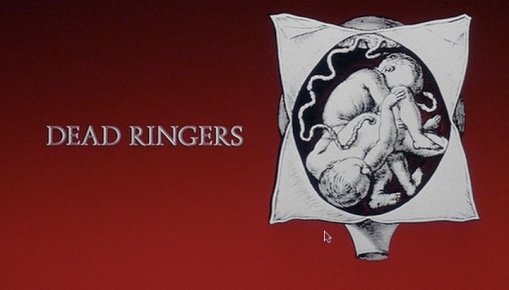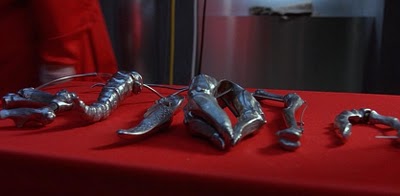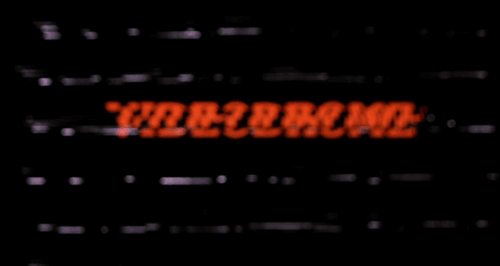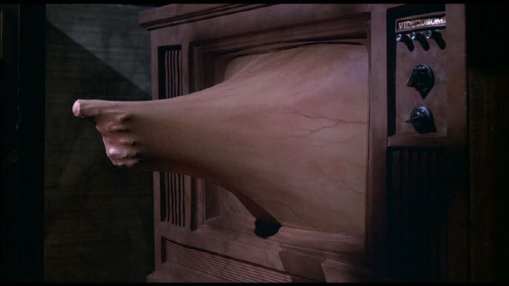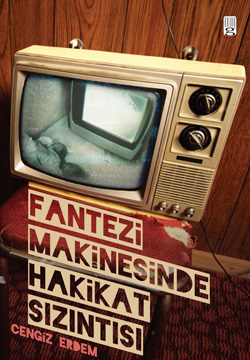
organ without a body
The Naked Lunch I am concerned with here is David Cronenberg’s film about William Burroughs’ writing process of Naked Lunch. The film, rather than being a direct adaptation of the novel, is a distillation of Burroughs’s life as he strives to write himself out of the past. We see Burroughs progressively deteriorating to the level of a dumb beast as he tries to make sense of his sufferings in and through writing. In the introduction he wrote for the 1985 edition of his earlier novel Queer, the writing of which dates back to 1953 following the two years period of depression, guilt, and anxiety ridden self-hatred after his accidental shooting of his wife Joan in September 1951, Burroughs, in an almost confessional manner, explicates the sources of his compulsion to write. Writing, for Burroughs, represents his lifelong pursuit of getting out of consciousness and reaching the area between fantasy and reality.
I am forced to the appalling conclusion that I would never have become a writer but for Joan’s death, and to a realization of the extent to which this event has motivated and formulated my writing. I live with the constant threat of possession, and a constant need to escape from possession, from Control. So the death of Joan brought me in contact with the invader, the Ugly Spirit, and maneuvered me into a lifelong struggle, in which I have had no choice except to write my way out.[1]
The death of Joan creates a space within Burroughs into which he escapes, and attempts to fill with his writings. Cronenberg explicates what Burroughs had already implied in his introduction to Queer. In the film writing in particular and creativity in general is shown to be a response to a traumatic incident, that is, production of fantasies to compensate for the horrors of life. As the film proceeds so does the mental deterioration of Bill Lee who represents Burroughs in the movie. The first signs of Lee’s split come when he is arrested by two policemen for “the possession of dangerous substances.” What they are talking about is the bug-powder which, Lee, who has given up writing to become a bug exterminator, uses to kill insects. The two policemen ask him to demonstrate his profession. One of them puts an insect the size of a hand on a pile of bug powder to see if the insect will die. As the insect begins moving its wings, arms, and legs they leave the room and Lee with the insect. As soon as they leave the room the insect tells Lee through a mouth-anus at its back that it has instructions for him, that it comes from the Interzone, that his wife Joan is not actually human and that he has to kill her. The insect asks Lee if he could put some bug powder on its mouth-anus upon the application of which it starts to make noises and movements as if in an orgy. In the next scene we are in reality and Joan is asking Lee to put some bug powder on her lips. As wee see a few scenes later that the mouth-anus turns out to be the abyss, the bottomless depth, or the space in-between fantasy and reality in which Lee loses himself and shoots his wife.
This presentation of fantasy and reality side by side occurs throughout the film. It is when the gap between fantasy and reality disappears that the Unconscious manifests itself. In the case of Bill Lee the undesired event is pushed back into the unconscious in turn causing an accumulation of sadistic impulses in him. These sadistic impulses are then externalized in and through writing. For Burroughs writing was cathartic in that it liberated the untamed drives and prevented the manifestation of aggression in the external world. In Cronenberg what we see is almost the opposite of this attitude to writing. As we know from Dead Ringers, Videodrome, and eXistenZ, for Cronenberg writing and creativity have destructive rather than therapeutic effects on the writer. In the film Bill Lee emerges as the culmination of these two opposing views on not only the creative process but also the relationship between the creator and the creation, the subject and the object, mind and body. As the arena of this conflict Bill Lee’s world is that of the one in-between the internal and the external worlds, the Interzone, or in psychoanalytic terms the Unconscious, the Real, where there is no self or not self.
Interzone is Tangiers on the North African coast where Burroughs wrote Naked Lunch in 1953. In those days it was a place of escape for the self-exiled artists and artisans. At Interzone everyone has their own particular universality in one big universal cesspool and that cesspool is Lee’s fantasy world. The Real, or the Unconscious, is impossible to represent and all those monsters, bug-typewriters, and disgusting images are only the creations of Lee’s hallucinating mind. In it every universality is surrounded by many other universalities and each universality is a body without organs. Upon arrival at the Interzone Lee starts to see his typewriter as an insect resembling the one which he had first encountered in the interrogation room at the police station. The bug-typewriter becomes the mouth-anus mechanism, the partial object opening a gap through language in-between the body without organs and the organ without a body.
Orality is naturally prolonged in cannibalism and anality in the case of which partial objects are excreta, capable of exploding the mother’s body, as well as the body of the infant. The bits of one are always the persecutors of the other, and, in this abominable mixture which constitutes the Passion of the nursing infant, persecutor and persecuted are always the same. In this system of mouth-anus or aliment-excrement, bodies burst and cause other bodies to burst in a universal cesspool.[2]
Here Deleuze is referring to Melanie Klein’s Psychoanalysis of Children. The state of being which Deleuze summarizes is the paranoid-schizoid position of the child, the world of simulacra. At this stage, which preceeds Lacan’s mirror stage, the child is not yet capable of identification. There is an introjection-projection mechanism going on but the objects, internal and external, are experienced as bad objects. The conception of goodness has not yet developed in the child. Since there is no good object for the child to identify with there is no condition of possibility for the identificatory process with a good or a bad object, there is no self or not self.
The paranoid-schizoid position is followed by the manic-depressive position in which identification with a good object takes place. The passage from paranoid-schizoid introjection-projection to manic-depressive identification is the process of passing through the Interzone, or in Lacan’s words “traversing the fantasy.” In Deleuze’s terms this process is the hovering of an impersonal consciousness over the transcendental field of partial objects. The bug-typewriter is Lee’s impersonal consciousness manifesting itself in the form of a paranoid fantasy, a body without organs which is pretending to be an organ without a body. In fact it is neither a body without organs nor an organ without a body and yet it is both at the same time. It is a becoming in between being and non-being.
Cronenberg’s move is away from Burroughs’s Kafkaesque understanding of the body as metaphor and towards a Deleuzean narrative of the metamorphosis of the body in a literal sense. All those self-destructive creators are inverted into the spotlight in and through Croneberg’s films and this enables Cronenberg to contemplate on the creative process as an inversion of destructive process and fill the film with this contemplation. What we see in Naked Lunch is the death drive in conflict with the life drive.
In Deleuze the body without organs is the metaphor of the death drive. And since the death drive is a response to the fragmentation of the self, it can only take the form of a paranoid fantasy projected onto the Real. The body without organs is the partial objects brought together in a totalizing way, in a way that deprives them of their partialities.
What the schizoid position opposes to bad partial objects—introjected and projected, toxic and excremental, oral and anal—is not a good object, even if it were partial. What is opposed is rather an organism without parts, a body without organs, with neither mouth nor anus, having given up all introjection or projection, and being complete, at this price.[3]
The body without organs, then, is the absence of a connection between the subject’s inside and outside. The subject, in a state of total negation, neither eats nor excretes. It eats nothingness itself and becomes the catatonic (w)hole. It is not out of the body without organs that the subject is born but from the paranoid-schizoid position which consists of a not yet formed consciousness, an impersonal consciousness violently attacking the external world and splitting the given unities. As opposed to the body without organs it consists of projection and introjection of the partial objects surrounding the subject to create fantasies such as an illusionary ego, and learns to keep the body without organs, or the Real at bay. The paranoid-schizoid position is followed by the manic-depressive position which corresponds to the formation of the super-ego and the sustenance of a balance between id, ego, and super-ego.
Burroughs’s cut-up and fold-in techniques appear to be the two constituent parts of his defense mechanism against the spectre of Joan haunting him. To escape from the paralyzing state of being haunted by the spectre, that is, not to turn into a body without organs, he carries the projection-introjection mechanism to its furthest and literally and unconsciously puts words and sentences, partial objects, next to and within each other to make up discontinuities, cause ruptures and keep the Real at bay. Through giving a voice to the Real as it is before symbolization, Burroughs’s intends to prevent it from becoming real, from being actualized hence submitting the governance of his actions to an external force. It is this mechanism of repression inherent in the cut-up technique that causes what it tries to cure. The cut-up technique involves literally cutting-up passages and putting them together as a new text which would be neither the one nor the other, hence deforming the syntax. The fold-in technique involves folding into each other the different parts of the same text, hence distorting the order of time. In both states what is at stake is a total negation of the external world as a result of its being considered as hostile. In Burroughs the paranoid fantasy projected on the real replaces reality with its inverted version, that is, Burroughs turns what he imagines the external world to be against itself by creating a paranoid fantasy involving a scenario in which the subject believes itself to be governed by an internally constituted external and evil force. Burroughs discovered cut-up and fold-in techniques as a defense mechanism against the paranoid fantasy he constructed around himself. To get out of this mad symbolic world, he decided to slash it into pieces and connect it with other texts that are themselves torn apart.
Burroughs’s cut-up technique is a result of his search for a way of desymbolizing the paranoid symbolic world he had constructed and projected onto the external world. Burroughs thought resymbolization was therapeutic in that it gave voice to the evil within in the way of expelling it. Cut-up technique aims at desymbolizing the totalitarian system surrounding the subject and was a defense against the totalitarian nature of this resymbolization. Burroughs himself admits in a letter written to Kerouac shortly after beginning to use the cut-up and fold-in techniques that “writing now causes me an almost unendurable pain.”[4] In Naked Lunch the movie, the theme of the materiality of language recurs through the encounters between the bug-typewriter and Bill Lee. Bill Lee creates an insect within, projects it onto his typewriter, and talks with it. His creations have taken on lives of their own and are doing and saying things mostly against him.
 In Nova Express, Burroughs’s 1964 text, The Invisible Man says, “These colourless sheets are what flesh is made from—Becomes flesh when it has colour and writing—That is Word and Image write the message that is you on colourless sheets determine all flesh.”[5] Burroughs had a strong sense of the materiality of language. When he has The Invisible Man say “becomes flesh when it has colour and writing” he is in a way referring to the Unconscious as the invisible man who is striving to become visible to himself and to others in and through language.
In Nova Express, Burroughs’s 1964 text, The Invisible Man says, “These colourless sheets are what flesh is made from—Becomes flesh when it has colour and writing—That is Word and Image write the message that is you on colourless sheets determine all flesh.”[5] Burroughs had a strong sense of the materiality of language. When he has The Invisible Man say “becomes flesh when it has colour and writing” he is in a way referring to the Unconscious as the invisible man who is striving to become visible to himself and to others in and through language.
Foucault’s interpretation of Bentham’s Panoptic mechanism becomes relevant here. In Discipline and Punish Michel Foucault presents the Panopticon as a metaphor of how power operates within modern western society. A revolutionary apparatus for its time (19th century), the Panopticon was more than just a model of prison for Foucault, it was a mechanism to keep an absent eye on the prisoner, to keep them under control at all times.
The Panopticon functions as a kind of laboratory of power. Thanks to its mechanisms of observation, it gains in efficiency and in the ability to penetrate into men’s behaviour; knowledge follows the advances of power, discovering new objects of knowledge over all the surfaces on which power is exercised.[6]
The formulation of the concept of the Panopticon involves not only seeing without being seen, but also a mechanism that imposes both their differences and their resemblances upon the subjects. So the subject’s difference from other subjects is itself externally constituted, but is also internal to the subject. The subject is the product of the mechanism in which the subject finds/loses itself, and participates in the setting of the trap. Some subjects are produced in such a way as to act on an illusory sense of consciousness, that they are in control of their lives and events surrounding them, that they are freely choosing their destiny, when in fact all the rules and possibilities of action are always already set. In a panoptic mechanism taking on passive and submissive roles brings wealth, love, health, and even happiness. In a panoptic mechanism everyone is a slave, but some are less so than the others. In a panoptic mechanism submissiveness brings power. The system is such that the subject, to feel secure, takes on a passive role. In return the subject is recognized as worthy of a higher step on the social ladder, which brings an illusionary sense of security. The efficiency of the panoptic mechanism depends on its ability to produce submissive/adaptive/rational subjects.

Burroughs’s mind works exactly like a panoptic mechanism. And I think this has been one of the major concerns of Cronenberg throughout the shooting of the Naked Lunch. What we have in the movie is a man who has been caught up in a trap that he himself set. Bill Lee projects the construct of his psyche onto the external world and it is by doing this that he finds/loses himself in the trap, dismembered. The paranoid fantasy he constructs becomes so powerful that it engulfs him causing his detachment from the external world and leading to the eventual loss of the gap between fantasy and reality. It as this point that the Real slips through and tears him apart. He, in his mind, literally becomes a slashed monster, sees himself thus, as he is not, and becomes other than himself. His becoming-other, however, is in the wrong direction, or rather results in a confusion concerning the relationship between the subject and the object.
Burroughs believed that literature gives birth to action. He also saw writing itself as an action. At the end of the film we see Bill Lee at the border on his way back to Annexia from the Interzone. Two guards ask him what his occupation is. He says he is a writer. They want him to demonstrate. He takes out the gun from his pocket. Joan is at the back of the car. It’s time for their William Tell routine. Joan puts a glass on her head. Lee misses the glass and shoots Joan on the head. The guards are satisfied. The spectator witnesses this crime and remembers the person irrelevantly looking out of the window when they were slaughtering Kafka’s K. at the end of The Trial. Who was that person? Was it God? Was it a single man? Was it all of humanity?
[1] William Burroughs, Queer (New York: Penguin, 1985)
[2] Gilles Deleuze, The Logic of Sense, trans. Mark Lester (London: Athlone, 1990), 187
[3] Deleuze, The Logic of Sense, 188
[4] William Burroughs, Letters (New York: Penguin, 1994), 286
[5] William Burroughs, Nova Express, (London: Panther, 1982), 30
[6] Michel Foucault, Discipline and Punish, trans. Alan Sheridan (New York: Pantheon Books, 1977), 204




